Using Dripper Systems To Grow Massive Plants
Dripper Systems
Growers use dripper systems, such as the unidrain drip and drain system, to grow larger, healthier plants. Dripper systems deliver a water and nutrient solution directly to your plant’s root zone.
Dripper systems are usually pressurised, using a reservoir pump. They often use calibrated pressure compensating button (PCB) drippers to deliver a known volume of nutrient solution over a set time. The pump supplies the nutrient solution to feed and water your plants. Dripper systems are sometimes called a micro irrigation system.
A dripper system works by supplying nutrients from a reservoir through a network of tubes to irrigate your plants directly at the root zone. The nutrient solution emits, drip-by-drip, onto your plant’s growing media. The solution then soaks down, right through the media, to the root zone. Some runs out of the pot and away to waste. This is known as run-off.
What Is Run-Off?
If you use a dripper system, and want the best results, you need to ensure that you over-water the media by 20-30% at every feed. The nutrient solution that runs out of the pot to waste is called: “run-off”.
When you achieve 20-30% run-off at each feed, you give your plant the best chance of success. Overwatering (achieving run-off) flushes out old nutrients and reloads the media with fresh water and nutrients for your plant to access. This usually results in explosive growth and larger than expected yields. What’s not to like?
Calibrated Pressure Compensating Dripper Systems
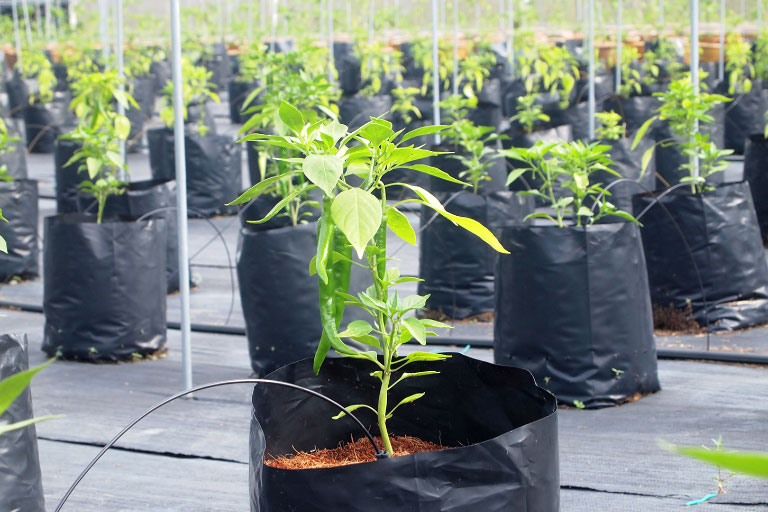
The best dripper systems use calibrated compensating drippers. These systems use a pump to deliver a known volume of nutrient solution to your plants. The pumps pressurise the feed lines so you feed at a constant rate. Calibrated dripper systems give repeatable results. They allow you to feed fresh, known strengths and volumes of nutrients to suit the plant’s stage of growth. They allow you to record your feeding regime and repeat it over again.
Benefits of Dripper Systems
Dripper Systems Are Versatile
You can use a dripper system with a variety of media, including coco and soil. Mixes are popular with Soil/Perlite 60/40 and Coco/Hydrolecca 70/30 mixes are a popular choice. For some systems, it’s possible to use clay pebbles instead of a medium. Doing this allows more air to circulate around the roots. Using clay pebbles will mean you need to feed more often as clay won’t hold on to the nutrient solution like coco or soil.
Dripper Systems Uses Less Water Than Other Systems
Even with the 20-30% run-off rate, dripper systems use less water. This is because dripper systems feed your plants directly at the root zone. They use less water and reduce water waste. A good drip irrigation system, directs all the nutrient solution to your media no losses.
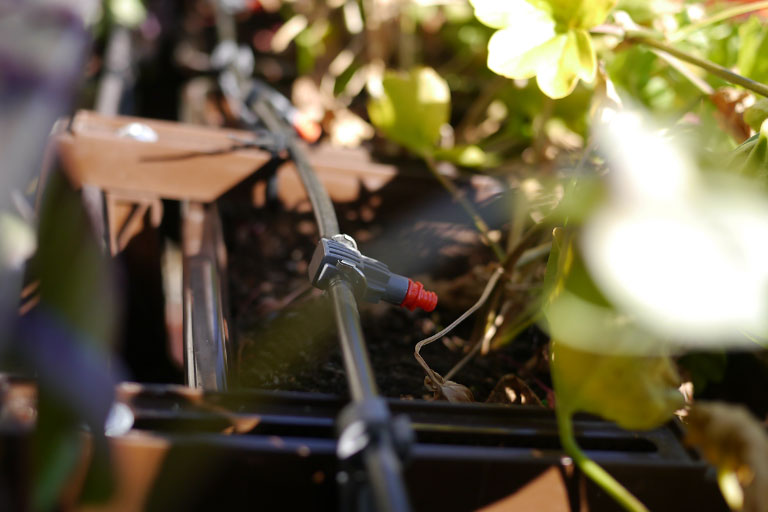
Uniform Water Delivery
Water penetrates into the media, placing moisture exactly where it’s needed – in the root zone. Plants grow faster with regular, uniform watering. It means they go without stresses, like drought stress.
Top Tips For Dripper Systems
Dripper Systems – Know Your Options
You’ll need to decide what you want out of your system. Based on what you’ve already read, do you want a recirculating or a run to waste system? Then, what kind of dripper delivery system is best suited to your needs? The following points cover:
- Recirculating
- Run to waste
Recirculating
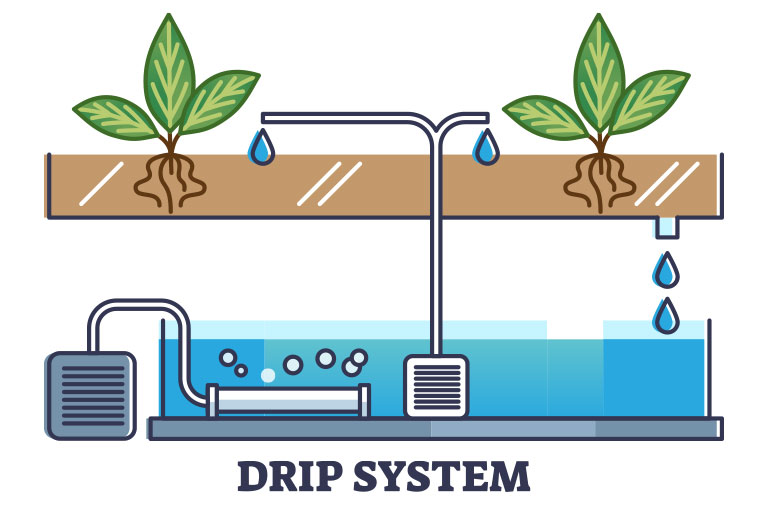
Recirculating dripper systems are usually favoured by home growers. The system uses a timer to control the pump that supplies the drip lines. The solution then flows back into the reservoir.
While this is a great system and you get to reuse the nutrient solution, it’s not very scientific. You can’t know explicitly what your plant is stripping from the solution. As a result, you can soon end up with nutrient deficiencies, which can soon show. The pH can quickly shift and cause you problems too.
Run to waste

Commercial growers favour Run to Waste (RTW) systems. They know these give them the repeatable outcomes they need. You can only repeat your results by duplicating a successful process. This includes feeding a known solution time after time. In a RTW dripper system you only use the nutrient solution once. Any runoff drains away to waste and disposed of. Using a RTW dripper system makes your pH easier to regulate. And it means that you’re feeding a known quantity of nutrients every time (and it’s repeatable)!
Using run to waste means you’re flushing the nutrients through the plant and media. Excess drains away and doesn’t build, leading to issues. Run to waste systems are THE choice, if you want to a repeatable feeding regime to get the very best results.
Understand How Different Drippers Work
Drippers provide resistance to control the flow of nutrient to the plant. They’re generally sized in accordance to the volume of nutrient solution you that they deliver. In the case of most hydroponics drippers, this is usually 6.8 to 9 litres per hour.
Drippers are then further divided into:
- Pressure Compensating Drippers
- Non-Pressure Compensating Drippers
Pressure Compensating Button Drippers (PCBs)
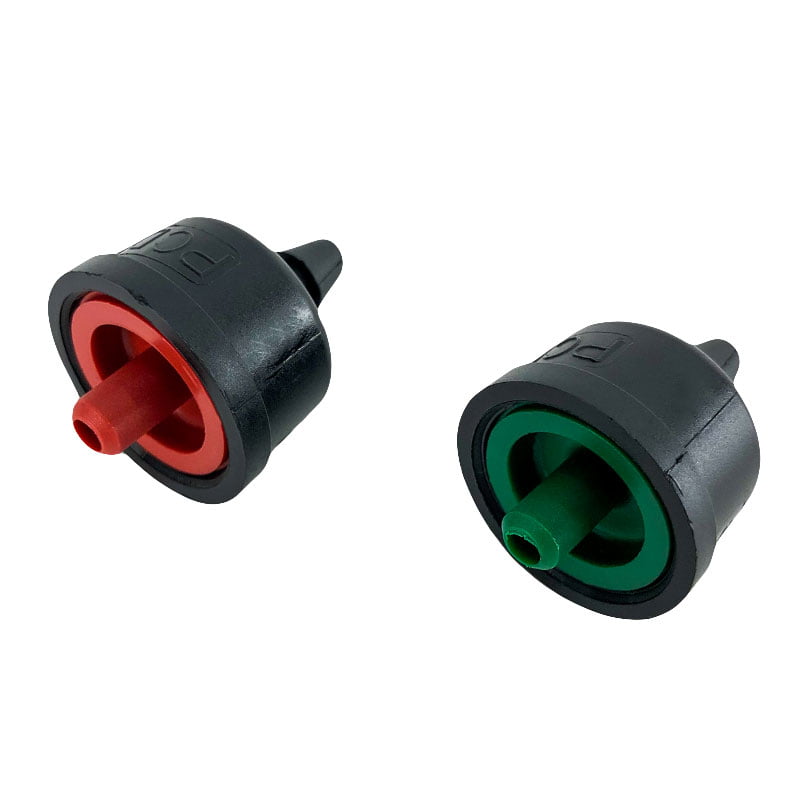
Pressure compensating drippers (also known as PCB’s Pressure Compensating Button drippers) release the nutrient solution at a consistent rate. The fact they compensate means that they give the same rate, regardless of the pressure. Pressure compensating drippers also reduce any potential clogging in the system.
Non-Pressure Compensating Drippers
Adjustable drippers have a screw on top. These allow you to adjust the flow of nutrient. By winding the screw top down onto the body of the emitter the flow of nutrient slows down or vice versa. This allows you to set up individual drippers in the same system. Non-compensating drippers allow you to deliver different rates of nutrient. You can have different plants recieving more than an other in the same system. Being able to remove the top of the emitter makes it easier to clean and remove any blockages.
Dripper Stakes
Dripper stakes work to anchor the dripper lines in the pots and direct the nutrient solution directly to the media. The media takes the nutrient solution and, through wicking, distributes it throughout the pot. Eventually the media reaches saturation and you’ll notice the run off from the bottom of the pot.
Always Monitor & Adjust Your System as Required
Plant nutrient requirements change as plants grow and develop. Drippers allow to make adjustments when needed. You’ll need to adjust your timer to increase or decrease the frequency of irrigation. Changes will depend on factors like:
- Plant type
- Plant size
- Growing conditions
- Lifecycle stage and medium
Choose the Right Medium For Your Dripper System

Coco coir’s high moisture retention ability means it won’t need irrigating as often. A free-draining medium, such as expanded clay pellets or coarse perlite will need more frequent irrigation. Before harvest, when you intend flushing your plants, you’ll need to increase the irrigation frequency.
Irrigation Times
20% Runoff Volume Calculated Over any 24-Hour Period
You should base your irrigation time calculations on your total runoff volume over a 24-hour period. If your runoff volume is calculated below 20% over a 24-hour period, you should increase feed times or feed more frequently.
Multiple or Single Feeds
If you feed multiple times per day, you don’t need 20% runoff on every feed. You only need to optimise your feeds times for 20% runoff over the course of the day. Conversely, if you do feed once a day, you do need to optimise that feed to achieve the 20% runoff rate.
Calculating Your Runoff – time
Calculating your runoff over a set time is the simplest way of working out irrigation times and runoff. This method works best if you’re feeding once a day.
NOTE: This method can also give a good indication when multiple irrigations are used.
- Time the feed.
- Note down the time when you see runoff.
- Record the time when the irrigation finishes (pump goes off).
- Work out runoff time as a percentage of total time.
Example – Single Feed Per Day
- First runoff is noticed at 9 minutes.
- Irrigation finishes at 10 minutes.
- 1 minutes of runoff time = 10%
- Add 5% to account for the additional runoff you get when the pump goes off = 15%
One solution for this issue could be to extend the time you feed for. Try adding another minute to your feed time and remeasure following the above steps.
Calculating Runoff – Measuring Total Runoff
This is the easiest way to keep your eye on runoff. After getting into a good routine with your irrigation times, measure total runoff to see if things are on track or need tweaking.
How Often Should I Feed?
The main variables to consider here are the types of growing media used and the plant size in relation to pot size.
Assuming you are using approximately 4 x 16 litre Air Pruners per 1-1.2M2, and have well established, fast growing plants, the following guide can be used.
| Media | Irrigation Frequency per 12 hours |
| Soil or Coco | 1 |
| 70/30 Coco/Perlite | 1-2 |
| 60/40 Clay Pebbles/Coco | 3-5 |
| Rockwool | 4-5 |
Drip Irrigation – When to Feed
- Don’t allow your growing media to dry back excessively between irrigations
- Your media should store around 30% of its total water holding capacity at the point the next feed is due
- Never allow your plants to wilt
Before you start feeding your plants, you want them to be actively transpiring (taking up water and nutrients). With this in mind it is a good idea wait an hour after the lights come on before beginning the feed cycle.
Only Use clean nutrients and Additives
To prevent blockages to PCBs and drip emitters, avoid using thick, viscous or lumpy organic feeds and additives.
Only use clean hydroponic feeds and additives with your dripper system.
Using enzyme products like: GrowDog Exotic Enzyme or Hygrozyme will help to prevent sediment build-up and blockages in irrigation lines, PCBs and drip emitters.
Understanding Pressures and Pipe Runs
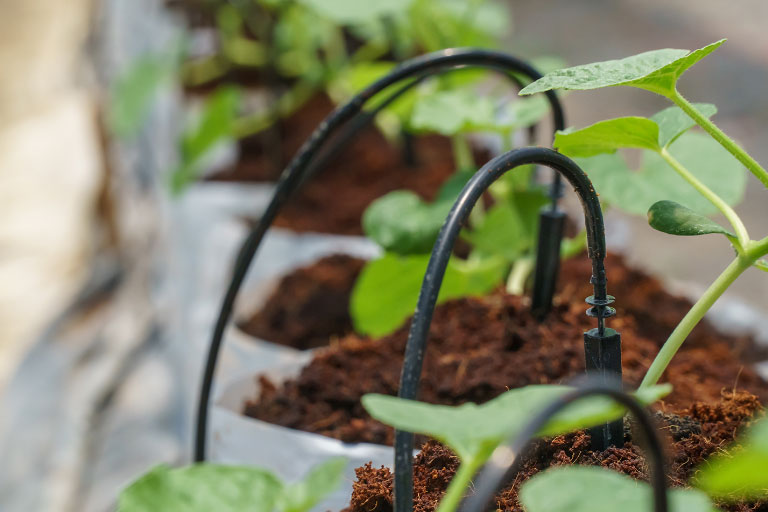
Repeatable, correct feeding gives your plants the best possible chance of success. To do this and repeat it, you’ll need to take records. You’ll need to record how long it takes to see runoff from the base of each plant after switching the dripper on. This will help you to form your guide time for each successive irrigation. However, this will need amending as the plant develops and consumes more. Be sure to check it and keep accurate records.
Dripper System Maintenance – Avoid Blockages
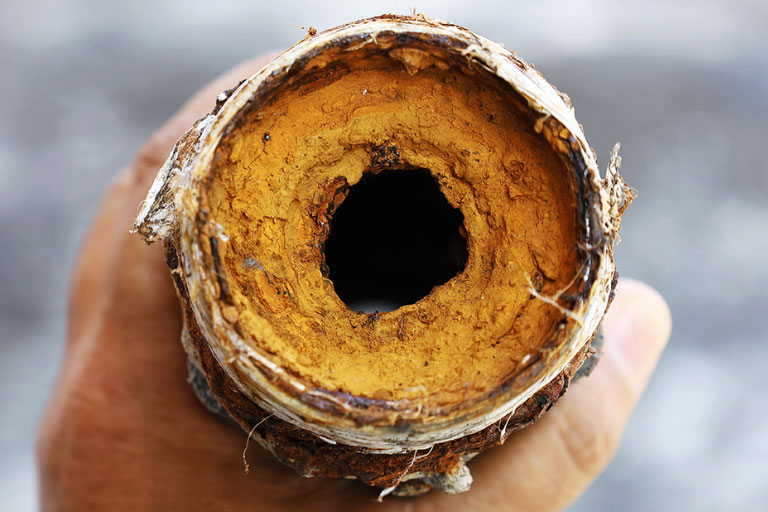
The main problem with drip irrigation systems can be when drippers clog with salts and sediments. While they might never get as bad as the above image illustrates, blockages will cause you problems in your carefully calibrated dripper system. To avoid issues, many growers employ a filter to remove sediments and other materials that may block drippers. If you use filters, you’ll need to regularly clean the filter itself. This will keep it doing the best job that it can.
Pre-filtering your water before you use it can be a good idea. Some water supplies contain high-levels of Iron minerals. These can be a major contributor to blockages. Drippers can block if exposed to direct light for too long, allowing for salt or algae to build up.
Recirculating hydroponic systems can block. Sometimes, organic material and particles get caught up in the circulating flow. To avoid this use the correct sized filters installed to catch any organic matter. To avoid plant stress from incorrect or broken emitters and drippers, check they all work when the system is on.
Know How to Remove Blockages if They Occur
Clear minor blockages by tapping the Dripper to dislodge whatever is causing the problem.
If you have a salt or sediment build up then soak the dripper in hot water for a few minutes to let it dissolve and clear. If your dripper is still blocked, you should just replace it.
To improve the lifespan of your system, clean it between grow-cycles. This will help to remove any trace of salt deposits, algae, and bacteria. Dripper systems are brilliant for automated feeding and can give you awesome results.
Dripper systems aren’t for lazy gardeners. For the best results, you’ll need to put in a little TLC to look after and maintain your equipment and plants.
Advantages of Using A Dripper System
If you want to benefit from well fed plants that have a constant access to a supply of carefully measured, fresh feed, then a dripper system is for you. The time saved and improved accuracy over hand feeding will help you grow larger plants with vastly improved yield potential.




